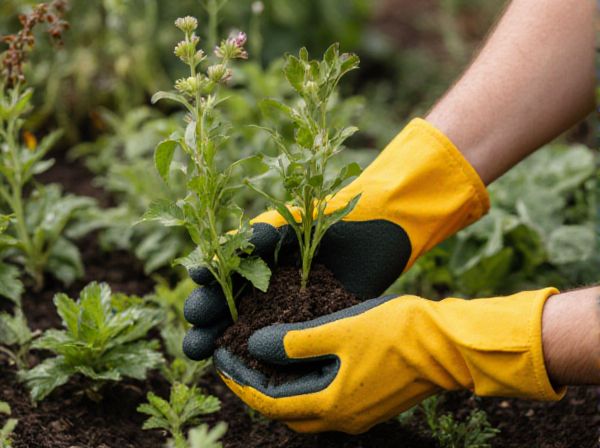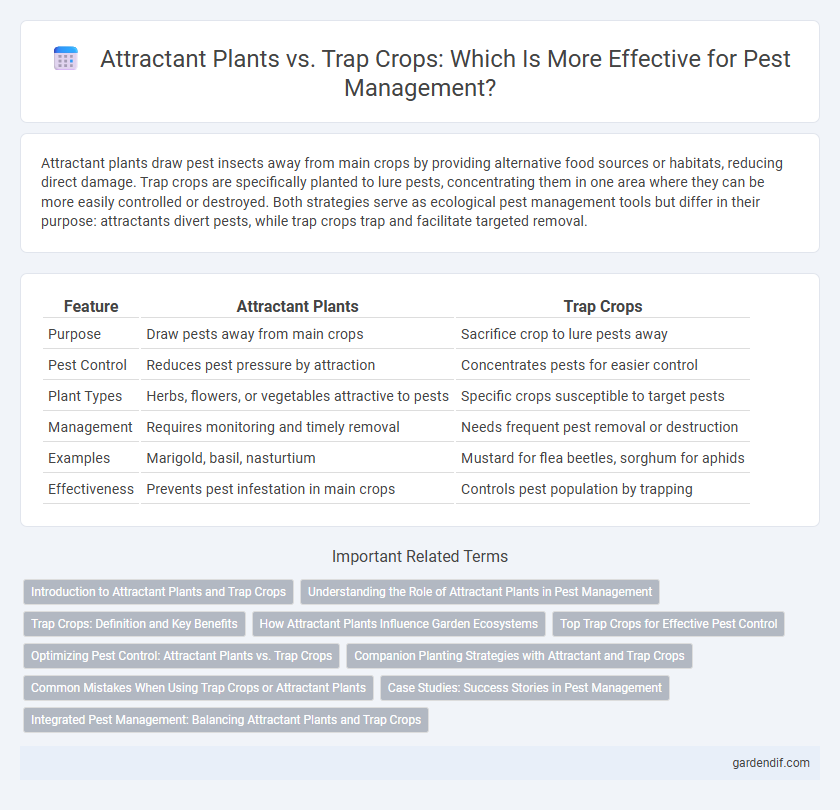
Attractant plants vs trap crops Illustration
Attractant plants draw pest insects away from main crops by providing alternative food sources or habitats, reducing direct damage. Trap crops are specifically planted to lure pests, concentrating them in one area where they can be more easily controlled or destroyed. Both strategies serve as ecological pest management tools but differ in their purpose: attractants divert pests, while trap crops trap and facilitate targeted removal.
Table of Comparison
| Feature | Attractant Plants | Trap Crops |
|---|---|---|
| Purpose | Draw pests away from main crops | Sacrifice crop to lure pests away |
| Pest Control | Reduces pest pressure by attraction | Concentrates pests for easier control |
| Plant Types | Herbs, flowers, or vegetables attractive to pests | Specific crops susceptible to target pests |
| Management | Requires monitoring and timely removal | Needs frequent pest removal or destruction |
| Examples | Marigold, basil, nasturtium | Mustard for flea beetles, sorghum for aphids |
| Effectiveness | Prevents pest infestation in main crops | Controls pest population by trapping |
Introduction to Attractant Plants and Trap Crops
Attractant plants are species specifically chosen to lure pests away from valuable crops by providing alternative feeding or breeding sites, effectively reducing pest pressure on the main crops. Trap crops function similarly but are cultivated in proximity to the primary crop to concentrate pests, facilitating easier pest management and minimizing damage to the main harvest. Understanding the strategic use of both attractant plants and trap crops enhances integrated pest management by exploiting pest behavior and movement patterns for sustainable agricultural practices.
Understanding the Role of Attractant Plants in Pest Management
Attractant plants play a vital role in pest management by luring pests away from main crops, reducing direct damage and minimizing pesticide use. These plants release specific volatile compounds that exploit pest behavior, enhancing targeted control strategies in integrated pest management (IPM) systems. Understanding the chemical ecology of attractant plants enables the development of sustainable practices that protect crop yield while maintaining ecological balance.
Trap Crops: Definition and Key Benefits
Trap crops are specific plants cultivated to lure pests away from main crops, effectively reducing pest damage and protecting valuable yields. These plants act as a sacrificial barrier by attracting insects or pests, concentrating infestations and preventing spread to primary crops. Key benefits include decreased pesticide use, enhanced pest management, and improved crop health and productivity.
How Attractant Plants Influence Garden Ecosystems
Attractant plants enhance garden ecosystems by drawing beneficial insects such as pollinators and natural pest predators, thereby improving plant health and biodiversity. These plants emit specific chemical signals that lure pests away from primary crops, reducing the need for chemical pesticides and promoting sustainable pest management. Integrating attractant plants into garden design fosters a balanced ecosystem that supports pest control through natural biological interactions.
Top Trap Crops for Effective Pest Control
Top trap crops such as marigold, mustard, and radish play a crucial role in effective pest control by diverting pests from main crops, thereby reducing pest damage. These trap crops are strategically planted to lure pests away, minimizing the need for chemical pesticides and promoting sustainable agriculture. The use of trap crops like trap corn for armyworms and Sudan grass for aphids enhances crop protection by creating pest sinks that suppress pest populations.
Optimizing Pest Control: Attractant Plants vs. Trap Crops
Attractant plants lure pests away from main crops by providing an alternative feeding or breeding site, enhancing targeted pest management and biodiversity. Trap crops, specifically planted to concentrate pest populations, enable localized pesticide application and reduce overall chemical use. Combining attractant plants with trap crops optimizes pest control by exploiting pest behavior and minimizing damage to economically important plants.
Companion Planting Strategies with Attractant and Trap Crops
Companion planting strategies utilize attractant plants to lure pests away from main crops by providing preferable host sites, effectively reducing pest pressure. Trap crops, strategically planted to intercept pests before they reach valuable plants, act as decoys, capturing and concentrating infestations for easier management. Combining attractant plants and trap crops creates an integrated pest management approach that enhances crop protection while minimizing chemical pesticide use.
Common Mistakes When Using Trap Crops or Attractant Plants
Common mistakes when using trap crops or attractant plants include selecting non-target species that fail to lure specific pests effectively, resulting in poor pest control. Overreliance on a single attractant plant without monitoring pest populations can lead to missed infestations or pest proliferation in surrounding crops. Neglecting the spatial arrangement and timing of planting often reduces the efficacy of trap crops, allowing pests to bypass these deterrents and reach valuable plants.
Case Studies: Success Stories in Pest Management
Studies on attractant plants like marigolds demonstrate their effectiveness in luring pests away from main crops by exploiting pest behavior and sensory cues. Trap crops such as mustard planted around cotton fields have successfully reduced pest infestations and minimized insecticide use in commercial agriculture. Field trials in India and the United States highlight that integrating attractant plants and trap crops can enhance sustainable pest management by reducing crop damage and improving yield.
Integrated Pest Management: Balancing Attractant Plants and Trap Crops
Integrated Pest Management (IPM) strategically employs attractant plants to lure beneficial insects that prey on pests, enhancing natural pest control. Trap crops serve as sacrificial plants that draw pests away from main crops, reducing crop damage without widespread pesticide use. Balancing attractant plants and trap crops in IPM optimizes pest suppression while promoting ecological sustainability and crop yield stability.
Attractant plants vs trap crops Infographic

 gardendif.com
gardendif.com